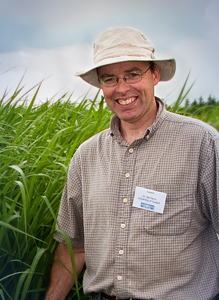By Samantha Beattie, Students Promoting Awareness of Research Knowledge (SPARK)

A green energy source that’s as good for the environment as it is for the economy has yet to be found. But U of G researchers believe perennial grass is a promising biofuel source that requires few agricultural inputs yet yields high amounts of energy.
Plant agriculture professor Bill Deen and graduate student Kate Withers are part of a team working to adapt two types of perennial grasses — miscanthus and switchgrass — to Ontario conditions.
They are also evaluating the grasses’ bioenergy potential.
“Perennial cropping systems may offer ecological and environmental benefits to the Ontario landscape,” says Deen. “They may also offer socioeconomic benefits because they provide an opportunity for producers to diversify their crops and invest in low-risk markets.”
Some annual biofuel sources, such as corn and canola, have been criticized for being too nutrient intensive, reducing the long-term productivity of soil. But perennial grasses have an advantage over annual crops: they don’t need to be replanted every year, and they have a longer growing season. That results in an extensive root system, enabling the plants to prosper in shallow and fragile soils, and they require less fertilizer and other nutrient inputs, says Deen.
Once these grasses are harvested, they can be burned to produce heat for industrial or residential applications, and can be a cost effective and environmentally friendly fuel. Deen and Withers suggest other uses for perennial grasses in the production of bioproducts such as succinic acid and cellulosic ethanol, or as agricultural substitutes such as livestock bedding and mushroom compost substrate.
But to get to that stage, the plants first have to flourish in Ontario’s climate. For her part, Withers is studying why some varieties of cold-tolerant miscanthus are able to survive the winter months. From there, she will develop a way to screen for improved germplasm to narrow the selection down to the varieties that are best suited for Ontario production.
These efforts are part of a broader initiative to lower the costs and risks associated with the successful establishment of perennial grasses.
“It takes three years for perennial grasses to reach their full height, making them quite expensive to establish,” says Withers. “That’s why it is important to get high yields as quickly as possible.”
Along with adapting miscanthus to Ontario’s climate, the researchers are also investigating the use of nurse crops (plans of a different species) that can grow in between rows while the grasses are maturing. Nurse crops will help farmers generate income as they switch to perennial crop production.
————————–
Collaborators include University of Toronto professor Rowan Sage and Dr. Ian McDonald of OMAFRA. Funding is provided by the OMAFRA – U of G Partnership.